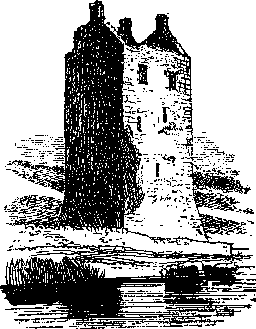Chapter 4: Eanach Dúin (Annaghdown) to Coill Beag
- Parish of Annaghdown
- Disaster of Annaghdown
- Monastery and Abbey
- Nunnery
- Bellhouse
- Annaghdown Castle
- Craobh Castle
- Kilcoona Round Tower
- St. Cuana
- Cloch-an-Uabhair Castle
- Lee's Island
- Cnoc Ferry and Coill Beag
Return to table of contents
Refer to Map
Passing round the little creek to the south of the ecclesiastical ruins, we reach the walled-in bounteous well of St. Brendan, and gain access to the tall, square tower-castle (see illustration) that forms so conspicuous and attractive an object both from the lake and land sides all round. It is exceedingly well built, and, like all the castellated remains in this district, batters gradually at the base. The entrance, on the south face, is by a pointed-arch doorway, strongly fortified by all the defensive contrivances of the period, and the character of the warfare of the time. To the left of the porch is a long flag-roofed guard-room and square door. Two other doorways with angle-arched heads open, one into a small chamber, and the other into the winding stone stairs that gave access to the upper portion of the building.In the roof of the porch is the usual poll-na-morrough, through which missiles might be poured on those who had so far gained access to the inside.

In the thickness of the wall is a square tube leading from the outer door-jamb, and which was probably used for communicating with those beyond, like a modern acoustic apparatus. Other flues of a like nature, but larger, exist in different parts of the building, and also passages formed in the thickness of the walls. The corbels that supported the floors and the chimney breasts are still in situ, and the garde robe is on the north face. In 1586 "Nicholas Lynch [held] Annaghcoyne."
To the south of the castle are the remains of an old house, said to have been that of the diocesan; and on the shore, to the south-west, is St. Cormac's Well, where "stations" are still occasionally performed on Sundays and Fridays. From a point between these two last mentioned places, the best view of the Annaghdown group of ruins may be obtained.
Besides those just described, this extensive parish contains several other objects of antiquarian and historic interest; in fact--to use the parlance employed in other writings--"too numerous to mention," unless in a minute parochial survey. It abounds in raths; and among its ruins may be mentioned--besides Druim grifín, referred to already--the tall, well-built Castle of Druim Buadh, with its adjoining Well of St. Cyprian, Mace Castle, the old church of Cillín, and the circular-towered Caisleán Craoibhe; but, except the latter, they are either too far distant from the lake to be accessible, or not of sufficient interest to be dwelt upon.